Earnings segregation at work: evolving isolation of higher earners from others in 12 countries
Earnings segregation at work: evolving isolation of higher earners from others in 12 countries

 Image Who is Danny (via Shutterstock)
Image Who is Danny (via Shutterstock)
The Great Separation: Top Earner Segregation at Work in Advanced Capitalist Economies
Olivier Godechot, Donald Tomaskovic-Devey, István Boza, Lasse Folke Henriksen, Are Skeie Hermansen, Feng Hou, Jiwook Jung, Naomi Kodama, Alena Křížková, Zoltán Lippényi, Silvia Maja Melzer, Eunmi Mun, Halil Sabanci, Max Thaning, Paula Apascaritei, Dustin Avent-Holt, Nina Bandelj, Alexis Baudour, David Cort, Marta M. Elvira, Gergely Hajdu, Aleksandra Kanjuo-Mrčela, Joseph King, Andrew Penner, Trond Petersen, Andreja Poje, Anthony Rainey, Mirna Safi, and Matthew Soener
American Journal of Sociology
Vol. 130, n° 2, p. 439-49, September 2024
https://doi.org/10.1086/731603
 Earnings segregation at work is an understudied topic in social science, despite the workplace being an everyday nexus for social mixing, cohesion, contact, claims making, and resource exchange.
Earnings segregation at work is an understudied topic in social science, despite the workplace being an everyday nexus for social mixing, cohesion, contact, claims making, and resource exchange.
Analyzing linked employer-employee panel administrative databases, the authors highlight the evolving isolation of higher earners from other employees in 12 countries between 1990 and 2019: Canada, Czechia, Denmark, France, Germany, Hungary, Japan, the Netherlands, Norway, Spain, South Korea, and Sweden.
They find in almost all countries a growing workplace isolation of top earners and a significant decrease in the exposure of top earners to bottom earners.
Tha authors isolate three key intertwined factors that account for this development:
- deindustrialization and reorganization of the manufacturing sector;
- decline in workplace size and restructuring of workplaces, through outsourcing, layoffs, offshoring, and subcontracting and
- digitalization of the labor process.
The paper therefore shows that the restructuring of national economies and workplaces, highlighted by previous research on the current transformation of work and firms, is also leading to a significant change in the potential for social cohesion. Together, these contributions inform the social science literatures focused on segregation, inequality, and cross-class cohesion and antipathy.
These findings open up a future research agenda on the causes and consequences of top earner segregation.









